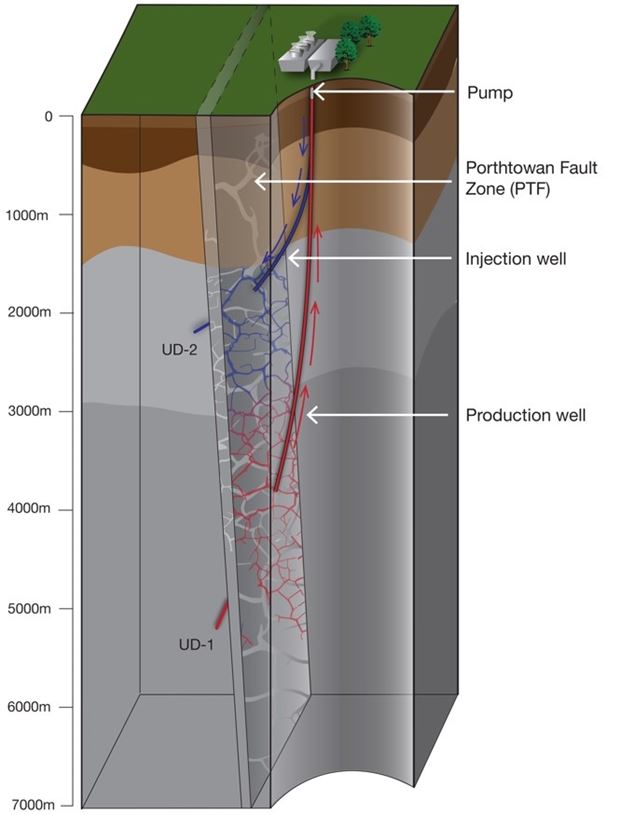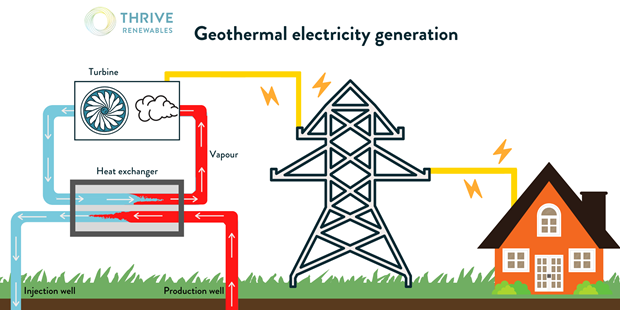12 Aug 2020
How does it work: geothermal electricity generation
While commonly thought to only be found in volcanic countries such as Iceland or New Zealand, geothermal energy is used in more than 20 countries to generate electricity, with more than 12GW1 of capacity installed worldwide. Due to its unique geology (large areas of granite), with very hot rocks much closer to the surface than other areas of the country, Cornwall is the perfect place to harness this natural, renewable resource. United Downs is the first geothermal electricity generation project in the UK.
But how do you turn heat found in the rocks under our feet into electricity we can use in our home?
First, we need to get to where its hot
United Downs consists of two wells drilled into the rock to different depths at a specific angle. The ‘injection’ well, reaches a depth of a 2,393m and the ‘production’ well reaches a depth of 5,275m, the deepest ever drilled in the UK. They are both drilled at a specific angle to intercept the Porthtowen Fault Zone (PTF) at these depths.
The PTF is a fault zone which stretches from Porthtowen in the north of Cornwall and Falmouth in the south. It is an area of rock filled with fissures, or cracks, which allow water to filter through it. The PTF stretches deep into the earth. Where the production well intercepts it, the temperature is 188 Centigrade.
The schematic below describes how the project will work once fully operational.

Now we’ve reached the heat, how do we get it to the surface?
We use ordinary water to transfer the heat to the surface. Hot water is pumped from the bottom of the production well to the powerplant at the surface where it is turned into electricity. After this process, the cooler water is then passed to the injection well where it then filters through the fissures found in the PTF, absorbing the heat from the surrounding rock as it heads towards the production well. Then the cycle begins again.
So how do we turn hot water into clean electricity?
Surprisingly, this part is well established. Much like your traditional thermal powerplant, United Downs uses steam to turn a turbine which generates electricity. The key difference is where the steam comes from.
Hot water from the production well is passed through a heat exchanger. This uses a special liquid with a very low boiling point to extract the heat from the well water, turn it into vapour, which in turn turns the turbine, generating renewable electricity. The cooled water is then returned to the system to restart its journey.
Geothermal energy production produces zero emissions as it does not use, produce, or extract hydrocarbons. It has a low visual impact and small land use.
The diagram below shows how electricity is generated from the system planned for the United Downs project.

Infographic demonstrating how electricity is generated from geothermal energy
What’s happening now?
Testing work at United Downs was delayed during lockdown due to supply chain issues and to protect the health of staff and suppliers. The team have adapted their practices to ensure a Covid safe environment. Recent testing has unearthed the deepest rock sample ever taken in the UK and revealed temperatures of 188 centigrade, hot enough for geothermal electricity generation. They are now busy testing flow rates of the water through the fissures. We hope to be exporting clean electricity to the grid at United Downs by the end of 2021.
What is the history of the project?
The long history of mining and various research projects into Cornwall’s geology carried out in the 1980s have generated substantial evidence and knowledge about Cornwall’s geology. ‘Hot Dry Rocks’, a long-running geothermal energy research project, in operation between 1976 and 1991, confirmed the high temperatures which are found deep underground in Cornwall’s granite, identifying its potential to provide renewable electricity and heat.
The Geothermal Engineering team has worked on the United Downs project for the past 10 years. During this time, they have successfully completed the research on the geology of the location, analysed the location of the PTF, secured planning consent, land lease and grid connection, and procured and delivered the drilling works. The successful drilling of the injection and production wells into the fault zone was completed in the Summer 2019.
[1] Total global installed geothermal capacity, 2015, International Geothermal Association (https://www.geothermal-energy.org/explore/our-databases/geothermal-power-database/#electricity-generation-by-plant)